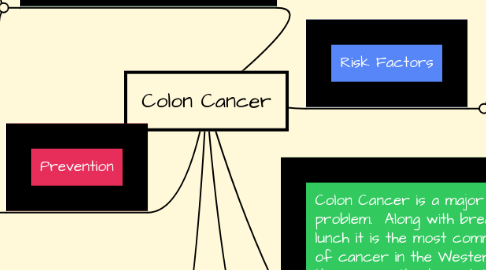
1. Detection and Colonoscopy
1.1. Maths
1.1.1. Text book, exercises 34, 35, 36, 37
1.2. The key to colon cancer detection and cure is a colonoscopy. If there is colon cancer in an immediate blood relative such as a parent, sibling, or cousin, then a colonoscopy is recommended at age 40. Since polyps are slow growing, a repeat colonoscopy in these situations is often recommended every 305 years thereafter. If there is no colon cancer in the family history then colonoscopy at age 50 is recommended.
1.2.1. Virtual Colonoscopy = this is an x-ray exam which can detect moderate sized polyps. However, these can not be removed and if polyps are found, then colonoscopy still must be performed to remove them.
1.2.1.1. Other tests = there is a stool smear test that can be done to detect microscopic amounts of blood that a larger cancer may shed. However, most polyps do not leak blood so these would not be detected. This test is not a good substitute for colonoscopy.
1.2.1.1.1. A barium enema is a X-ray exam. With this test the colon must be cleaned out like a colonoscopy. If a polyp is detected then a colonoscopy still needs to be done to remove them.
2. Prevention
2.1. Spanish
2.1.1. New vocabulary
2.2. Reduce your weight significantly
2.2.1. Exercise, even moderate walking on a regular basis helps.
2.2.1.1. Gradually move your diet to more of a plant based. This means more fruits, vegetables, and whole grains.
2.2.1.1.1. Reduce red meat ingestion. White meats, poultry, and fish do not see to be related to a higher incidence of colon cancer. Meat about the size of a deck of cards is enough.
3. Summary
3.1. Physics
3.1.1. Research and prepare experiment
3.2. Cancer of the colon is a serious but readily detected malignancy. Early detection and removal of polyps before they become cancer offers the best chances of cure and survival. This type of program of early detection and prevention should be discussed with your primary care physician on a regular basis.
4. Risk Factors
4.1. English
4.2. Heredity = There are some families that have a very strong genetic makeup for getting cancer. If you have close relatives such as siblings or parents, your risk of getting colon cancer is much higher.
4.2.1. Obesity = Being significantly overweight increases the risk of colon polyps and cancer. This is likely directly related to the types of foods that are eaten. Sedentary living habits also seem to increase the risk.
4.2.1.1. Fiber, Vegetables and Fruits = Food fiber seems to be very protective against getting these tumors. It is now known that fiber within plant foods feed the very best bacteria within the gut. These bacteria in turn seem to keep the lining of the colon much more health and less likely to change to cancer.
4.2.1.1.1. Calcium = Low calcium ingestion has been associated with colon cancer. This may related to liver bile which flows into the intestine and then may cause abnormal cell changes.
5. Colon Cancer is a major health problem. Along with breast and lunch it is the most common form of cancer in the Western world. However, unlike breast, lung, and many other forms of cancer, colon cancer is remarkably preventable if colon polyps are discovered and removed before they can become cancer.
5.1. Spanish
5.1.1. Midterm

